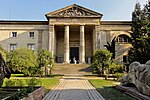Ménagerie du Jardin des plantes
Buildings and structures in the 5th arrondissement of ParisOrganizations based in ParisTourist attractions in ParisZoos in France

The ménagerie du Jardin des plantes is a zoo in Paris, France, belonging to the botanical garden Jardin des Plantes. Founded in 1794, largely with animals brought from the royal zoo of the Palace of Versailles, abandoned because of the French Revolution, it is the second oldest zoological garden in the world (after Tiergarten Schönbrunn). Today it does not have very large animals like elephants, but a lot of rare smaller and medium-sized mammals and a variety of birds and reptiles.
Excerpt from the Wikipedia article Ménagerie du Jardin des plantes (License: CC BY-SA 3.0, Authors, Images).Ménagerie du Jardin des plantes
Rue Cuvier, Paris 5th Arrondissement (Paris)
Geographical coordinates (GPS) Address Phone number Website External links Nearby Places Show on map
Geographical coordinates (GPS)
| Latitude | Longitude |
|---|---|
| N 48.844722222222 ° | E 2.3597222222222 ° |
Address
Ménagerie du Jardin des Plantes
Rue Cuvier 57
75005 Paris, 5th Arrondissement (Paris)
Ile-de-France, France
Open on Google Maps









